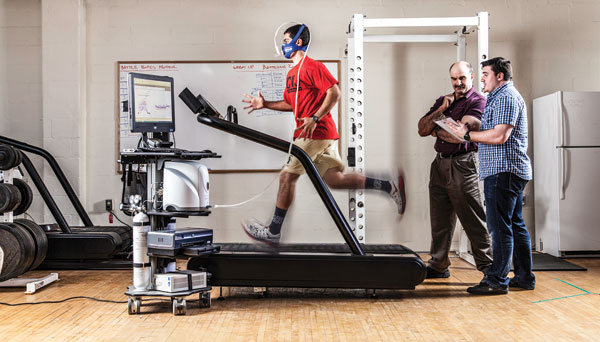Running for their lives
The Insanity Workout. CrossFit. P90X. Are these high-intensity, quickie workouts the most effective way to lose weight? See what this team of TCNJ researchers discovered.

Running For Their Lives

The Problem: The obesity epidemic has had terrible consequences for Americans’ health. The federal government has spent millions trying to get people to change how much and what they eat, and for years health professionals have been recommending a 20-minute aerobic workout, three or more times a week, to shed fat and become more fit. More recently, gyms, weight loss marketers and trainers have bombarded people with claims that metabolic programs with names like “The Insanity Workout,” “CrossFit” or “P90X”—which combine different forms of exercise with very short rests in between—will do the trick. Yet not everyone is convinced that high-intensity, quickie workouts are the most effective way of losing weight. “There’s a lot of debate over the best way of getting back in shape,” says Matthew Wells, part of a team studying the physiological effects of exercise in a tightly controlled setting.
Their fix: The team decided to compare the benefits of a standard 20-minute aerobic workout with a six-week metabolic program of its own design, combining aerobic exercise with resistance training. It recruited young men and women not currently involved in athletics. One group ran on the treadmill for 20 minutes; the other combined 10 minutes of running and 10 minutes of weight training. To find out which program burned the most calories, the students recorded how much metabolic energy participants expended during workouts. At the end of the study, subjects were also evaluated for changes in their maximal oxygen uptake, exercise economy, body composition and muscular strength.
Their takeaway: Preliminary results showed that both groups improved their fitness level. In some cases, the benefits were comparable. The running program improved endurance and cardiovascular conditioning but did nothing to improve muscle strength, while the combined running and weight training program improved upper and lower body strength. At the time this magazine went to publication the final analysis of data was not yet in, but “the combination of running and weight training seems to be pretty nice, if not for every variable, at least half of them,” reports professor Nicholas Ratamess. The team hopes to publish a paper in The Journal of Strength and Conditioning Research.
Professors: Nicholas Ratamess and Jie Kang
Students: Megan Flynn, Matthew Wells and Charles Smith
Posted on May 22, 2014

